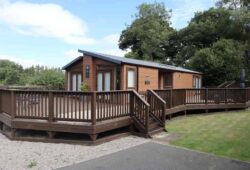A common question asked by RV owners is – why do campers get soft spots in floor.
This can be quite a concerning issue as not only can it compromise your camper’s durability; it can also lead to molds, which are a health risk.
With this in mind, it is very important to know why these soft spots arise, what can you do about it, and how you can avoid further issues in the future. Let’s investigate!
Contents
Why Do Campers Get Soft Spots In Floor
Living in an RV is quite convenient as it has all the basic amenities typically in a conventional house. Yet, if there are soft spots in the floor, this presents a problem that needs to be fixed immediately.
But first, why do soft spots happen?
For the most part, we can blame faulty plumbing or a leaky floor issue for soft spots. Since your camper floor is only crafted from plywood it can definitely become prone to moisture. There is vinyl covering as protection but this is not often the case with older campers.
In fact, older models may not even have such covering added in. In this case, water can get trapped on the wood and cause the material to rot. With the problem persisting and without early detection, you are looking at a potential replacement concern for the entire RV floor!
Detecting Soft Spots In RV Floor
Soft spots are unsightly without a doubt. And once you step on it, this is not pleasant at all. The problem is concerning because of so many issues whether it is the mold infestation, long-term damages, expensive replacement, or all of these things!
With that being said, you need to check your RV floor for soft spots. If you have purchased it – brand new or not – you should try to look for defects. It is best to do it straight away instead of waiting for the issue to get bigger and hit you smack right on the face.
The good thing about soft spots is that they are not hard to detect at all. In fact, all you need to do is to push the floor simply with your hands.
If you would rather not get your hands involved, you can also walk around the area. If there is some give or mushy feeling on the floor, chances are there is some rotting happening. And yes, it is due to soft spots.
Another thing you can do is by accessing the underneath of your camper. You can grab a screwdriver to push the material and check for anything rotting under there.
These are things you can do even before you purchase an RV. Then, you can spare yourself from bigger problems in the future if soft spots are already existing in your vehicle.
Read More: How To Clean Underside Of Camper Awning in Quick and Simple Ways
Checking For Damage And Fixing Soft Spots In The Floor
As we have mentioned earlier, soft spots are due to water damage. There are a few things you can do to make sure this issue does not exist. Once you have confirmed water damage is the culprit, you can go ahead and make the right decision on what to do next.
But first, here are the steps on how to check for water damage in your RV floor.
1. Inspect The Rig
The rig is an important area to be checked as regularly as possible. Consider this as a maintenance procedure to keep your RV in good shape.
You may want to look for any signs of water damage, so you will have to conduct a thorough check after you have had a long camping season.
In case you have parked your vehicle for a while, you also need to check for signs of water damage. Carry out these inspections as regularly as possible since soft spots do not only present themselves when water leaks right away.
Hence, do this inspection weekly, so you can know for sure if you need to worry about water damage in the floor.
2. Prepare Your Tools
As you keep using your Rv, there will always be a chance of a water spill or leak on the floor.
With this being said, you have to be prepared with the right tools for any necessary fixes. Have your repair tools ready to patch up small leaks as quickly as possible.
Speaking of fixes, you will first need to remove the area that is already damaged. The styrofoam and wood must be completely removed before you can work on the floor. Then, be sure to clean the floor well but avoid applying water to the places that remain intact.
Also, keep in mind that molds are not far behind when there are soft spots on the floor. Thus, you will have to rely on the powerful action of a mold-killing chemical while disinfecting the spots.
If you opt for a natural way to kill molds, you can also use hot water and borax. But be sure to exercise caution since there are health risks involved when you use these products incorrectly.
Lastly, you will have to rebuild your floor. You need to replace all the wooden parts that are completely damaged and have no proper support left. Make the floor stronger with the right materials and repair broken plumbing pipes if there are.
Conclusion
We hope this answers your question – why do campers get soft spots in floor. As you can see, there are a few reasons why this happens, which can yield worrisome issues in the future.
So, to avoid the need for massive repair work and costly replacement, be sure to check for soft spots even before you purchase your RV.
But if you are already in your RV, and you want to prevent further damages, inspect the floor for any soft spots as regularly as possible. Then, you can preserve its lifespan and eliminate any health risks such as molds that come with soft spots.




